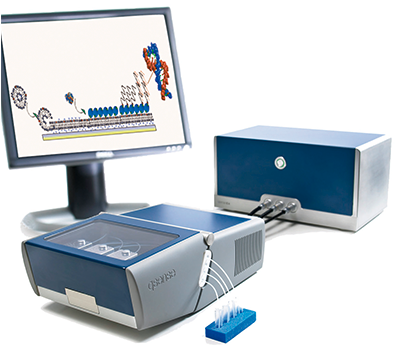
介绍:QCM-D技术的核心是石英晶体传感器,它由石英晶体夹在两片电极中间形成三明治结构。在电极两端加入一个交流电压,在传感器的共振频率处引发一个小的剪切振动,当交流电压关闭后,振动呈指数衰减,这个衰减被记录下来,得到共振频率(f)和耗散因子(D)两个参数。
对于薄层硬质薄膜,可以使用Sauerbrey关系和公式,根据传感器振动计算吸附层的质量。当沉积的薄膜松散和粘性时,能量通过薄膜上的摩擦被消耗,传感器的振动发生衰减,耗散因子提供了传感器上吸附的薄膜的结构信息。通过使用多个频率和耗散因子数据,使用粘弹性模型而非Sauerbrey关系,我们可以计算得到质量、厚度、粘度和弹性。
主要特点:
E4 Auto作为Q-Sense公司具有耗散因子检测功能的第三代石英晶体微量天平,采用全自动液体处理系统,四通道进样装置完全由程序设定,可自动完成进样与实验。该系统可以对多种不同类型表面的分子相互作用和分子吸附进行研究,应用范围包括蛋白质、脂质、聚电解质、高分子和细胞/细菌等与表面或与已吸附分子层之间的相互作用。
E4可以测定非常薄层的吸附层的质量,并同步提供如粘弹性等结构信息。它基于QCM-D专利技术,非常灵敏和快速,可提供多个频率和耗散因子数据,用于充分了解在传感器表面吸附的分子的状态。
Introduction: As the second generation of Quartz Crystal Microbalance with Dissipation monitoring (QCM-D) from Q-Sense, the E4offers the opportunity to study molecular interactions and molecular adsorption to many different types of surfaces.Applications include proteins, lipids, polyelectrolytes, polymers and cells/bacteria interacting with surfaces or withpreviously bound molecular layers.
The instrument determines the mass of very thin surface bound layers and simultaneously gives information abouttheir structural (viscoelastic) properties. It is based on the patented QCM-D technique, an extremely sensitive and fasttechnique providing multi-frequency and dissipation data that are needed to fully understand the state of molecularlayers bound to the sensor surface.
Today QCM-D plays a key role in the investigation of biomaterials, development of surfaces for biosensing and biochipsand in fundamental research to understand processes taking place on surfaces or in thin films. It is often used as a complementto optical and imaging techniques such as Surface Plasmon Resonance (SPR) and Atomic Force Microscopy (AFM).
Q-Sense E4 is a complete turnkey instrument and includes everything needed to quickly get started and produce highquality data. The instrument has four flow modules, each holding one sensor. The flow modules can be used in anyserial or parallel configuration to suit different measurements needs. It also includes software that allows the system toextract the thickness, viscosity and elasticity of adsorbed layers as well as fitting to kinetic models.
中心及团队标准:0/小时;125/样品 校内标准:0/小时;250/样品 校外标准:0/小时;500/样品